
Guests
- Winona LaDukeOjibwe environmental leader and executive director of the group Honor the Earth.
While world leaders converge in Poland for the U.N. climate change summit, we look at the indigenous-led fight against destructive oil pipelines and the revolutionary potential of the Green New Deal with Winona LaDuke, Ojibwe environmental leader and executive director of the group Honor the Earth. She lives and works on the White Earth Reservation in northern Minnesota.
Transcript
AMY GOODMAN: The U.N. climate summit is underway in Katowice, Poland, with leaders calling for swift global action. U.N. Secretary-General António Guterres said in his opening remarks climate change is “a matter of life and death” for many nations and that the worst polluters are not doing enough to meet the goals of the 2015 Paris climate agreement.
While world leaders converge in Poland, the indigenous-led fight against destructive oil pipelines continues across North America. In Louisiana, activists suffered a blow Thursday when a judge ruled that the company building the 163-mile Bayou Bridge pipeline had the right to seize private land for construction under eminent domain. This comes despite the fact the judge ruled that pipeline owner Energy Transfer Partners had trespassed on private land during construction, and ordered the company to pay three landowners $150 each. The Bayou Bridge pipeline will carry nearly a half-million barrels of oil per day across Louisiana’s wetlands.
Meanwhile, incoming Congressmember Alexandria Ocasio-Cortez and other lawmakers are calling for a Green New deal to revolutionize the U.S. economy to combat climate change.
Well, earlier this week, I spoke with climate activist Winona LaDuke, Native American activist with the Ojibwe Nation, executive director of the group Honor the Earth. She lives and works in the White Earth Reservation in northern Minnesota. I began by asking her what an Indigenous Green New Deal would look like.
WINONA LADUKE: Well, indigenous people obviously have a lot of experience with sustainability, a lot of years of it. And so, if you look across the country, it turns out that the windiest places in the country are Indian reservations. For those of us who were at Standing Rock, Class VII wind. You know, one reservation in North Dakota, the Fort Berthold Reservation, has 17,000 times more wind than they could ever use. So, you start hooking those tribes up to the grid, which already crosses our land with some bad dam projects—look at places like the Navajo Nation, with five coal-fired power plants and four coal strip mines; look at their transition to new solar, for instance, the Kayenta Solar Project—and you’ve got kind of like a cornerstone. You know, we could call it energy justice, or we could just call it the enlightened economy—you know, really where we need to go. And then you look at the issues of agriculture.
I mean, you know, so I come from the White Earth Reservation in northern Minnesota, and we have a plan. You know, my plan is—first of all, I’m looking down the barrel of a very big pipeline, which is a $7 billion boondoggle of stranded assets. We’ll talk about that later. But I’m looking down the pipeline, you know, at the barrel of this pipeline, and I’m looking: What could $7 billion do in Minnesota? What could it do to make a New Green Deal?
So, in my territory, for instance, on the Iron Range, there’s a new solar plant that has gone in to make solar photovoltaic panels. And on my reservation, we are just beginning—and in February we should be operational—a solar thermal panel manufacturing facility to make solar thermal panels that you can put on the south side of your house and reduce your heating bill by about 20 percent. We have solar going in at 20 kilowatts and 200-kilowatt projects.
And then we have this larger vision, which, you know, it’s not just renewable energy. It’s efficiency, and then it’s also local foods and the next economy. Our interest in the next economy—I mean, to be honest with you, Amy, I didn’t really like this economy too much. Didn’t work out too well for my people, you know. So the next economy has to be something that reaffirms our relationship to the Earth and gives us a shot. That, to me, looks like a lot of local food, organic food. If you actually went organic in most of your agriculture, and, for instance—I just read an article—if you ate beans, you know, if we just upped the beans and diminished the cattle, you’d end up with sequestering the carbon in the soil. You know, you don’t need some guys to put something in the sky to keep the carbon out of the sky. You need to put it in the soil. And so you need organic agriculture. That’s what we’re doing in my community.
And the other thing that I’m working on is hemp. I have, for three years, been growing industrial hemp. And what I’m interested in is the next textile economy. This country, in the 1980s and the 1990s, offshored all of our textile manufacturing to Asia. And we don’t produce anything in this country. And I am a hemp grower. Hemp has three times the tensile strength of cotton. Hemp doesn’t use all the water, like 5,000 gallons of water for a T-shirt and jeans, doesn’t use all the chemicals. And, in fact, the word “canvas” comes from “cannabis.” And so, what I want to do is to rebuild the hemp industry in Indian country. And I want us at the table, not on the menu. I want us to be in the leadership of this next economy, because we have a lot of territory upon which you can grow hemp. And we can rebuild the light manufacturing industry in this country.
AMY GOODMAN: And yet you have a president, President Trump, who says climate change is a hoax. When it’s cold in New England, he says, “See? You’re talking about global warming?”
WINONA LADUKE: I’m not going to spend a lot of time rebutting President Trump. I mean, I would spend all day, you know, with that. I mean, to kind of the Native community, he’s kind of like the new incarnation of Andrew Jackson: you know, bad president for Indian people, bad president for everybody. But, you know, to us, and to be super honest, I mean, we don’t have a lot of experience with great presidents. You know, what we have experience with is that we’re going to fight this out, and we’re going to make the next economy. We’re going to make our future. That’s what self-determination is about.
AMY GOODMAN: So, talk about pipeline politics. And for those who aren’t familiar with the pipeline you’re fighting, give us a map of it. You know, interestingly, I was just interviewing Congressmember-elect Deb Haaland of New Mexico. She’s one of two Native American women, the first two—the other Sharice Davids of Kansas—who will be in Congress ever.
WINONA LADUKE: Yeah.
AMY GOODMAN: Deb Haaland went to the standoff at Standing Rock.
WINONA LADUKE: Standing Rock, yes.
AMY GOODMAN: It was a school for so many, even those who are weighing going into electoral politics.
WINONA LADUKE: So, that is right. I mean, Standing Rock was an example of, you know, regulatory capture, when your whole system is controlled by corporations, and in a state that we call the “Deep North.” You know, and you experienced the Deep North. And, you know, so we all got a lesson at Standing Rock. We got a pretty good lesson. And, you know, since that time, pipelines have not gone so well for any of these corporations.
So, just to give you a context, about a year and a half ago there were five tar sands pipelines proposed out of Canada. Now, think of Canada with that pretty guy Trudeau. You know, they might as well just name that pipeline after him he just bought. I mean, he talks about signing up with Paris, but, you know, Canada is a huge polluter, and if the tar sands come online, that’s pretty much game over. But that’s what they’re trying to do. So, to make—you know, to be—
AMY GOODMAN: And explain, just to be clear, about when you said that Trudeau bought.
WINONA LADUKE: So, just to give you this context, about a year and a half ago there were five pipelines proposed out of the tar sands. Tar sands is a landlocked mass of sand that has some oil in it. Super-expensive stuff, super—you know, really bad for the environment. One pipeline was called Energy East. That was to go from Alberta to New Brunswick. The second pipeline was called the Northern Gateway. That was to go from Alberta to the Pacific Coast. The third pipeline was called Trans Mountain, Kinder Morgan’s Trans Mountain. The fourth, Keystone. And the fifth pipeline is called Enbridge Line 3. Five big pipelines to try to get some oil out that’s landlocked.
So, if you look at what’s happened, about a year ago, the Energy East pipeline did not get approved by the National Energy Board. Nobody, it turns out, wanted a pipeline crossing Canada. Surprise, surprise. Montreal didn’t want it. Nobody wanted it. Second pipeline, Northern Gateway, Enbridge’s Northern Gateway, the gem of their Canadian projects, was not approved by the National Energy Board. That leaves three pipelines.
One pipeline known as the Kinder Morgan, facing massive opposition, not only from First Nations but by the good citizens of British Columbia—and the premier of British Columbia opposed—ended up in court because they did not consult with First Nations. The federal court in Canada, the appeals court, revoked all of the permits, nullified all of the permits on Kinder Morgan’s pipeline known as the Trans Mountain pipeline. The same day that that happened, premier Trudeau purchased that pipeline, hoping—you know, for like $4.9 billion; I think the price tag is now something like $15 billion—so that he would—you know, that Canada would have its own personal pipeline to cross the territory. You know, I think it’s kind of a dodgy investment, myself, judging by the courts and judging by the fact that the courts stop pipelines.
Keystone pipeline, as you know, Trump moved ahead, sprinkled his little fairy dust. That pipeline was stopped again in the federal court in Montana. That should be a year, two years—who knows how long?—if they are ever able to meet the conditions. Stopped because Trump, it turns out, could not reverse an Obama decision without a reason. You can’t just go do it because you want to because you’re president .
AMY GOODMAN: And Obama finally stopped it after years of mass protest.
WINONA LADUKE: Right, years of mass—I mean, social movements and lawyers are who stop pipelines. Social movements and lawyers.
This leaves one pipeline that is still considered somewhat viable. That pipeline is Enbridge’s Line 3. That is a 915,000-barrel-a-day tar sands pipeline going from Alberta to Superior. And what is very significant about that pipeline, aside from the fact that it’s the equivalent of 50 new coal-fired generators coming online—exactly what you do not need in the face of the U.N. report and the president’s own reports on climate change out of the administration—but, in addition to that, that feeds into every other pipeline that goes through, for instance, the Straits of Mackinac, the pipeline that is 60 years old. Enbridge’s pipeline is a feeder for most of the infrastructure in the northern Great Lakes territory. So that pipeline is what we are fighting.
And unfortunately for all of us, the Public Utilities Commission of Minnesota issued a rogue decision in favor of that pipeline. You know, to tell you what I mean by a rogue decision is that—you know, I’ve been here a few times talking about this pipeline. But, you know, we had three years of hearings on this pipeline. Seventy-two thousand people came out and testified, of which 69,000 people testified against the pipeline. Equal amount of evidence. The Department of Commerce did not recommend issuing a certificate of need for that pipeline. And in addition to that, the administrative law judge, which reviewed the pipeline for three years, recommended against issuing a permit for the route. In June of this year, the Public Utilities Commission of Minnesota disregarded all evidence, disregarded all recommendations by every agency and issued a permit. And just a couple days after Thanksgiving, they reaffirmed that permit.
AMY GOODMAN: Winona LaDuke, Native American activist with the Ojibwe Nation, executive director of the group Honor the Earth. Back with her in a minute.
[break]
AMY GOODMAN: This is Democracy Now!, democracynow.org, The War and Peace Report. I’m Amy Goodman, as we continue our discussion with Winona LaDuke, Ojibwe environmental leader, executive director of the group Honor the Earth. She lives and works on the White Earth Reservation in northern Minnesota. I sat down with her earlier this week.
AMY GOODMAN: So, describe your area for us. You know, when you come on to Democracy Now!, we always say you’re on the White Earth Reservation in northern Minnesota. But describe it for us and where this pipeline is.
WINONA LADUKE: You know, I think about my territory as where the wild things are. Where the wild things are. I have, you know, lynx. I have wolves. I have bears. You know, there are no caribou there now, but there are moose. There are elk. You know, I live in a place where there are still insects. I live in a place where there is still life. And so, that place is northern Minnesota, covered by treaty territories—1855, '54, ’37 and ’42—full of wild rice, full of lakes, lakes that you can still drink from. Lakes that you can still drink from. That's where I live. And that’s what this battle is about. It’s about, you know: Can we protect that?
AMY GOODMAN: When do they say the pipeline will be built?
WINONA LADUKE: They’ve been trying to build it for three years. You know, they say that they will begin construction this year. But, as I said, we are now entering the appeals process. We are hoping that the state of Minnesota joins us in appealing the decision by the PUC, because it was unsupportable according to the Department of Commerce, legally and in any realm. I mean, the insurance itself—the state approved a $1.4 billion insurance agreement with the Enbridge corporation. That was based on the Kalamazoo spill, which was a much smaller spill that’s not really catastrophic. Plus, doesn’t include the 17,000 miles of pipeline that Enbridge has.
And for me, this is part of, you know, what the New Deal has really got to be about. I mean, we are a country that has a D in infrastructure. We have a D in infrastructure. Lawrence, Mass., blows up. Bridges crumble. You know, we are probably losing 30 percent of our gas in aging infrastructure in this country. And so what we need is a New Deal that builds infrastructure for people, not for oil companies. As I said, $7 billion that is for an oil company pipeline, that could be spent much better.
AMY GOODMAN: I’m looking at this invoice you brought in regarding climate damages. Explain.
WINONA LADUKE: Right. OK, so we’ve issued an invoice to the Enbridge corporation, because, you know, in all of their hearings they talk about their power plants are going to be—their pumping stations will be powered with solar. Lipstick on a pig. And, you know, they talk about the climate impact of this pipeline is not significant.
Well, we have a math team at Honor the Earth. And what we figured out is that the carbon equivalent of what they are carrying, if you had to take that out of the environment—which is what basically we have to do—the trending rate is $1,000 a metric ton. And so, the amount of carbon that Enbridge is carrying in, just the carbon itself, is worth $170 billion in expenses annually. The total due, you know, kind of if you’re doing some math and aggregating the combined impact of such a badly planned project, is $266 billion annually.
And so we have issued an invoice from the creator—you know, Honor the Earth acting on behalf of the creator—to the Enbridge corporation, saying that they should pay this amount. We would prefer to have it early on, because, according to Moody’s, they were downgraded to just above junk bond status in December. And so, with the experience that Americans and Native people have of multinational corporations like Enron going bankrupt, we think it would be wise to collect the money in advance.
AMY GOODMAN: So you’ve got Line 3 carbon, metric ton, then boreal forest.
WINONA LADUKE: Yeah. There’s a price to destroying boreal forest.
AMY GOODMAN: And explain what a boreal forest is.
WINONA LADUKE: The tar sands is a boreal forest. You know, and you turn something that is the oxygen of the North—I mean, the boreal forest of northern Canada—of Canada is the equivalent of the lungs. It’s the Amazon of the North. It’s the Amazon of the North. And that is what is being destroyed by the tar sands. Wetland—this is just going through our wetlands. The value of a wetland—you know, I’m an economist by training, but how do you value a wetland for what it does for Mother Earth and for the planet and for your water and for insects and for where the wild things are? You know, but there are some numbers that have been associated with it. We did some math. We multiplied those numbers out. You know, Enbridge’s math skills were not ours. And so, you know, we’ve issued this invoice.
AMY GOODMAN: And finally, social cost.
WINONA LADUKE: You know, I’m not sure how to quantify that, but the perfect example is, is that even without a spill, you know, the threat of a spill in a community who relies on wild rice is very traumatic. Having a megaproject shoved down your throat causes suicide in Native communities. You know, we already have diabetes and every other epidemic that you do not want to have, and nothing in this pipeline contributes to our well-being. So who’s paying for that? Who’s paying for that? The state of Minnesota is who made the decision to shove the pipeline down our throats, and so we will fight them. We will fight them.
AMY GOODMAN: What does the state and the federal government gain by these pipeline?
WINONA LADUKE: You know, I refer—
AMY GOODMAN: They’re private, right?
WINONA LADUKE: This is a private pipeline—
AMY GOODMAN: Unless it’s Trudeau buying Kinder Morgan—
WINONA LADUKE: Right.
AMY GOODMAN: —because Kinder Morgan says they can’t afford it anymore.
WINONA LADUKE: I mean, to be honest with you, I feel that the state of Minnesota, and now the state of Michigan, which is trying to approve a deal to put a tunnel around the pipeline under the Straits of Mackinac, around the pipeline, that Enbridge will pay for, but, you know, to just keep the oil going—I feel that the state suffers from the Stockholm syndrome. You know, they have been told by Enbridge that their pipelines are going to leak. And so, if their pipes are going to leak, you need to replace them. And so, my position to the state of Minnesota or the state of Michigan would be: remove the gun. You know, the Public Utilities Commission said they felt like they had a gun to their head by the Enbridge corporation, that the pipe was going to leak, and so they would need a new pipe. I said, “Remove the gun. Remove the gun. You’re a regulatory agency. You know, you need to get out of the Stockholm syndrome.”
And, you know, so there is the representation that there are jobs that will occur, but everybody knows that the 1,200 jobs that will occur over the course of six months of building—you know, what they will have a lot more jobs in is the militarization of the North. I mean, in this pipeline’s case, the state of Minnesota Public Utilities Commission, when they approved the pipeline, looked to the Enbridge corporation, a Canadian multinational corporation, and said, “Will you pay the police? Will you pay for the police that it will take to install this pipeline?” That’s what Commissioner Tuma said. And Enbridge said yes. And so, to me, that is a pretty significant crisis in democracy. We know that Standing Rock cost North Dakota $38 million, and they’re still trying to recuperate that. And so, since you have 300 miles of pipe that no one wants in Minnesota, try to project those costs, Minnesota.
AMY GOODMAN: What about insurance?
WINONA LADUKE: Ah, the insurance of Enbridge. You know, first of all, how do you insure for a big pipeline? I mean, they said it was $1.4 billion to clean up the Kalamazoo spill. The Kalamazoo pipe was about—
AMY GOODMAN: When was that spill?
WINONA LADUKE: 2010. And the Kalamazoo spill cost $1.4 billion, not necessarily fully cleaned up. But besides that, that was about 300,000 barrels per day. This pipeline is at 915,000 barrels per day. If they had a worst-case—and that, and the $1.4 billion for cleanup of the Kalamazoo spill, which went for 17 hours, in not a remote location, was not considered catastrophic by the Enbridge corporation. So, what is a catastrophic spill? You know, if that pipeline breached in Minnesota, the low estimates are $2.4 billion for a catastrophic spill. A spill of the Enbridge corporation’s 50-year-old pipeline in the Straits of Mackinac, well over $6 billion.
So, to me, one of the questions that I have is that: If you are a regulatory agency, why would you approve an insurance guarantee for lower than the price of any potential spill? And, in fact, it’s not in a kitty; it’s in Enbridge’s—it’s in Enbridge’s accounts. We would not make the assumption that there would not be more than one spill on an Enbridge line. There’s a spill almost every day, it seems. And so, that insurance policy, Enbridge’s total insurance policy that they are holding right now in their general insurance, is $940 million. And they have 17,000 miles of pipeline. No prudent regulatory agency would have approved an insurance settlement or an insurance agreement like that.
AMY GOODMAN: We’re broadcasting from Katowice, Poland, all week for the U.N. climate summit. These major reports have come out of both the United Nations and President Trump’s own administration.
WINONA LADUKE: Right.
AMY GOODMAN: Thirteen federal agencies, hundreds of scientists—which he poopoos because he says he doesn’t believe in climate change. But these reports that say we are in the endgame now. I mean, we just came from California, the fires there that devastated communities.
WINONA LADUKE: Yeah. I mean, you know, as I look out there, this is the time of, you know, catastrophes of biblical proportions, if we are going to call it that. You know, to the south, you have the great floods. To the west, the entire West Coast is on fire. To the north, the ice is melting, and polar bears are eating each other. And to the east, you have a crazy man with orange hair whose theme song seems to be Talking Heads’ “Burning Down the House.” You know, I mean, I have no idea. That is catastrophe in itself, you know?
And so, I look out there as an indigenous person. Our prophecies talk about this time. I can tell you that. I could say, “We told you so.” You know, for the past hundred years we’ve been saying—you know, for the past hundred years we’ve been saying, you know, in the time of the seventh fire, you’re going to have to make a choice between two paths: one well worn and scorched, and the other not. And that is this moment, you know, where we have a choice.
And in my analogy, you know, one time I was sitting in Sitka, Alaska—did you ever get a chance to go there? Beautiful. Like sometimes you just go someplace. I was at a writers’ workshop. I was in Sitka, Alaska, and I was watching—you know, the eagles were capturing the salmon that had come in. And so there was like eagles diving down into the ocean, and, you know, the salmon. And there were bears. And I looked out there, and I saw this cruise ship coming into the left of my vision. And it came in, and I was like, “Oh, I don’t like that.” The cruise ship came in, and then I watched that cruise ship turn a 180 and go exactly back out.
And that’s basically what we’ve got to do. You know, we have to make the next economy, and that next economy is going to be green. That next economy is going to have people like me making decisions. I’d like to be an architect for the next economy. I didn’t like the last one.
AMY GOODMAN: Well, you ran for vice president with Ralph Nader.
WINONA LADUKE: I did. I did run for vice president.
AMY GOODMAN: Are you considering electoral politics again?
WINONA LADUKE: Well, I did just—I did just apply for an appointed position on the Minnesota Public Utilities Commission. The chair has now left, and I have announced—I submitted my application to be on the Minnesota Public Utilities Commission.
AMY GOODMAN: Who decides?
WINONA LADUKE: I believe the governor. And in my personal opinion—I mean, in my experience, you know, I have a lot of interest in infrastructure and public policy. I’ve spent a whole life working on it. And I think we should have infrastructure for people, and there should be equitable infrastructure. So, you know, that is my next position that I’m applying for. We will see how it goes.
AMY GOODMAN: Who is the governor that will decide?
WINONA LADUKE: Well, Walz may decide. I think Walz will probably decide, although Dayton is in. And in Minnesota, you know, what I have to say is that we also worked to get out the vote. Minnesota had the highest record of voter turnout in a midterm election of any state. And my reservation and my community, we took our bus—we have a bus that says “Stop Line 3”—and we ran what we called Rez Uber. We drove people to town to ride the bus—we drove people to town to vote. And we personally got a lot of people out to vote who never would have voted in this election.

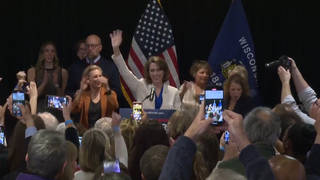
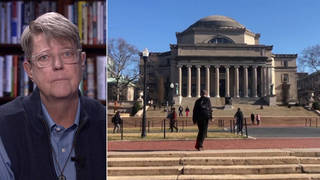
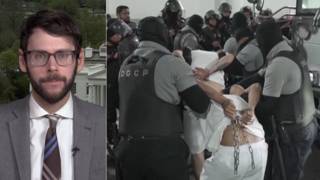
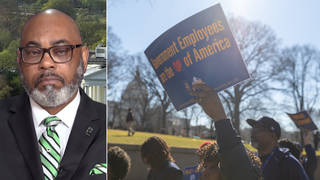





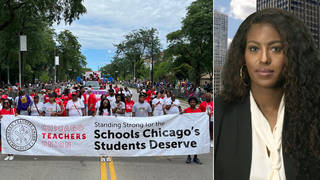
Media Options